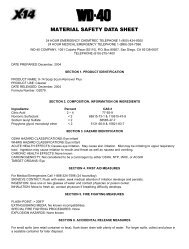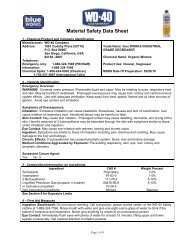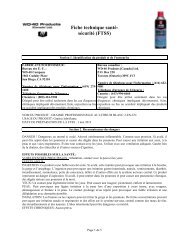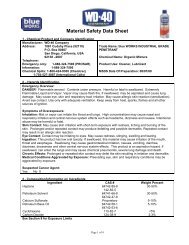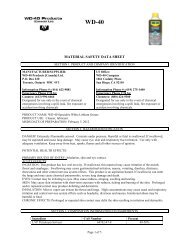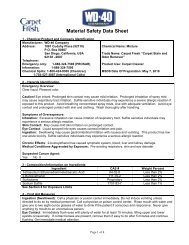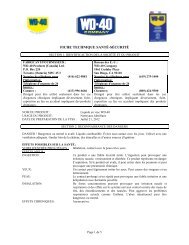Material Safety Data Sheet (MSDS) - WD-40
Material Safety Data Sheet (MSDS) - WD-40
Material Safety Data Sheet (MSDS) - WD-40
You also want an ePaper? Increase the reach of your titles
YUMPU automatically turns print PDFs into web optimized ePapers that Google loves.
<strong>Material</strong> <strong>Safety</strong> <strong>Data</strong> <strong>Sheet</strong><br />
1 - Chemical Product and Company Identification<br />
Manufacturer: <strong>WD</strong>-<strong>40</strong> Company<br />
Address: 1061 Cudahy Place (92110)<br />
P.O. Box 80607<br />
San Diego, California, USA<br />
92138 –0607<br />
Telephone:<br />
Emergency only: 1-888-324-7596 (PROSAR)<br />
Information: 1-888-324-7596<br />
Chemical Spills: 1-800-424-9300 (Chemtrec)<br />
1-703-527-3887 (International Calls)<br />
Chemical Name: Organic Mixture<br />
Trade Name: <strong>WD</strong>-<strong>40</strong> No-Mess Pen<br />
Product Use: Lubricant, Penetrant, Drives Out<br />
Moisture, Removes and Protects Surfaces From<br />
Corrosion<br />
<strong>MSDS</strong> Date Of Preparation: 6/8/12<br />
2 – Hazards Identification<br />
Emergency Overview:<br />
DANGER! Harmful or fatal if swallowed. May cause eye irritation. Avoid eye contact. Use with adequate<br />
ventilation.<br />
<strong>WD</strong>-<strong>40</strong> No-Mess pen contains 7.7 mL of liquid. The liquid contents are only released in a controlled manner<br />
when the tip of the pen is pressed. No free liquid is present under normal conditions of use. This product<br />
presents only a minimal fire and exposure hazard.<br />
Symptoms of Overexposure:<br />
Inhalation: Overexposure is very unlikely due to product form. High concentrations may cause nasal and<br />
respiratory irritation and central nervous system effects such as headache, dizziness and nausea. May<br />
aggravate existing respiratory conditions such as asthma. Intentional abuse may be harmful or fatal.<br />
Skin Contact: Prolonged and/or repeated contact may produce mild irritation and defatting with possible<br />
dermatitis.<br />
Eye Contact: Contact with the liquid contents may be mildly irritating to eyes. May cause redness and<br />
tearing.<br />
Ingestion: Ingestion of significant amounts is extremely unlikely due to product form. This product has low<br />
oral toxicity. Swallowing of the liquid contents may cause irritation, nausea, vomiting and diarrhea. The liquid<br />
contents are an aspiration hazard. If swallowed, can enter the lungs and may cause chemical pneumonitis.<br />
Chronic Effects: None expected.<br />
Medical Conditions Aggravated by Exposure: None expected.<br />
Suspected Cancer Agent:<br />
Yes No X<br />
3 - Composition/Information on Ingredients<br />
Ingredient CAS # Weight Percent<br />
Aliphatic Petroleum Distillates 64742-47-8 60-70<br />
Petroleum Base Oil 64742-58-1<br />
20-30<br />
64742-53-6<br />
64742-56-9<br />
64742-65-0<br />
Non-Hazardous Ingredients Mixture
4 – First Aid Measures<br />
Ingestion (Swallowed): Ingestion of significant amounts is very unlikely due to product form, however liquid<br />
contents are an Aspiration Hazard. DO NOT induce vomiting. Call physician, poison control center or the<br />
<strong>WD</strong>-<strong>40</strong> <strong>Safety</strong> Hotline at 1-888-324-7596 immediately.<br />
Eye Contact: Flush thoroughly with water. Get medical attention if irritation persists.<br />
Skin Contact: Wash with soap and water. If irritation develops and persists, get medical attention.<br />
Inhalation (Breathing): Inhalation overexposure is very unlikely due to product form. If irritation is<br />
experienced, move to fresh air. Get medical attention if irritation or other symptoms develop and persist<br />
5 – Fire Fighting Measures<br />
Extinguishing Media: Use water fog, dry chemical, carbon dioxide or foam.<br />
Special Fire Fighting Procedures: Firefighters should always wear positive pressure self-contained<br />
breathing apparatus and full protective clothing.<br />
Unusual Fire and Explosion Hazards: The liquid contents of the pen are not flammable but will burn under<br />
fire conditions. However, the pen contains a small amount of the liquid and the contents are released only<br />
when pressure is applied to the tip. The product presents only a minimal fire hazard.<br />
6 – Accidental Release Measures<br />
Large spills of this product are unlikely due to product form. If pen leaks, wipe up any free liquid and place the<br />
pen and the waste in an appropriate container for disposal. In manufacturing and storage where large<br />
numbers of pens may be damaged, eliminate all sources of ignition, ventilate area and collect the pens into a<br />
container for disposal. Collect any released liquid with an inert absorbent and place in a container for<br />
disposal.<br />
7 – Handling and Storage<br />
Handling: Keep product away from open flame. Keep away from children. Replace cap on pen when not in<br />
use. Avoid contact with eyes. Avoid prolonged contact with skin.<br />
Storage: Store away from excessive heat and flames.<br />
8 – Exposure Controls/Personal Protection<br />
Chemical<br />
Occupational Exposure Limits<br />
Aliphatic Petroleum Distillates<br />
Petroleum Base Oil<br />
Non-Hazardous Ingredients<br />
1200 mg/m3 TWA Manufacturer Recommended<br />
5 mg/m3 TWA OSHA PEL/ACGIH TLV<br />
10 mg/m3 STEL ACGIH TLV<br />
None Established<br />
Engineering Controls: No special ventilation is normally required.<br />
Personal Protection:<br />
Eye Protection: None should be needed for normal use. Avoid eye contact.<br />
Skin Protection: None needed for normal use. Avoid repeated or prolonged contact with skin. Wear<br />
impervious gloves if needed to prevent possible skin irritation<br />
Respiratory Protection: None should be needed for normal use.<br />
Work/Hygiene Practices: Wash with soap and water after handling.<br />
Note: For bulk processing, general body-covering clothing, safety goggles and impervious gloves are<br />
recommended as good industrial hygiene practice. If needed, a NIOSH approved respirator appropriate for<br />
the level of exposure should be worn.<br />
9 – Physical and Chemical Properties<br />
Boiling Point: 323F Specific Gravity: 0.832 @ 72F<br />
Solubility in Water: Insoluble pH: Not Applicable<br />
Vapor Pressure: 0.07 mmHg @ 20°C (aliphatic Vapor Density: Greater than 1<br />
Page 2 of 4
petroleum distillates)<br />
Percent Volatile: 72% VOC: 0%<br />
Coefficient of<br />
Water/Oil Distribution:<br />
Not Determined Appearance/Odor Pen containing 7.7 mL of a<br />
cloudy, light amber liquid<br />
with a characteristic odor.<br />
Flash Point: >200F Tag Closed Cup Flammable Limits: LEL: 1.0% UEL: 9.0%<br />
10 – Stability and Reactivity<br />
Stability: Stable<br />
Hazardous Polymerization: Will not occur.<br />
Conditions to Avoid: Avoid excessive heat, flames and other sources of ignition.<br />
Incompatibilities: Strong oxidizing agents.<br />
Hazardous Decomposition Products: Carbon monoxide and carbon dioxide.<br />
11 – Toxicological Information<br />
The oral toxicity of this product is estimated to be greater than 5,000 mg/kg based on an assessment of the<br />
ingredients. This product is not classified as toxic by established criteria. It is an aspiration hazard. None of<br />
the components of this product is listed as a carcinogen or suspected carcinogen or is considered a<br />
reproductive hazard.<br />
12 – Ecological Information<br />
No data is currently available.<br />
13 - Disposal Considerations<br />
If this product becomes a waste, it would be not be expected to meet the criteria of a RCRA hazardous<br />
waste. However, it is the responsibility of the generator to determine at the time of disposal the proper<br />
classification and method of disposal. Discard empty pen in trash. Dispose in accordance with federal, state,<br />
and local regulations.<br />
14 – Transportation Information_<br />
DOT Surface Shipping Description: Not Regulated<br />
IMDG Shipping Description: Not Regulated<br />
15 – Regulatory Information<br />
U.S. Federal Regulations:<br />
CERCLA 103 Reportable Quantity: This product is not subject to CERCLA reporting requirements,<br />
however, oil spills are reportable to the National Response Center under the Clean Water Act and many<br />
states have more stringent release reporting requirements. Report spills required under federal, state and<br />
local regulations.<br />
SARA TITLE III:<br />
Hazard Category For Section 311/312: Acute Health<br />
Section 313 Toxic Chemicals: This product contains the following chemicals subject to SARA Title III<br />
Section 313 Reporting requirements: None<br />
Section 302 Extremely Hazardous Substances (TPQ): None<br />
EPA Toxic Substances Control Act (TSCA) Status: All of the components of this product are listed on the<br />
TSCA inventory<br />
California Safe Drinking Water and Toxic Enforcement Act of 1986: This product does not contain<br />
chemicals regulated under California Proposition 65.<br />
Canadian Environmental Protection Act: One of the components is listed on the NDSL. All of the other<br />
ingredients are listed on the Canadian Domestic Substances List or exempt from notification<br />
Canadian WHMIS Classification: Not a controlled product.<br />
This <strong>MSDS</strong> has been prepared according to the criteria of the Controlled Products Regulation (CPR) and the<br />
<strong>MSDS</strong> contains all of the information required by the CPR.<br />
Page 3 of 4
16 – Other Information:<br />
HMIS Hazard Rating:<br />
Health – 1 (slight hazard), Fire Hazard – 1 (slight hazard), Physical Hazard – 0 (minimal hazard)<br />
SIGNATURE:<br />
TITLE: Adm. Scientific Manager<br />
REVISION DATE: June 2012 SUPERSEDES: January 2010<br />
Page 4 of 4



